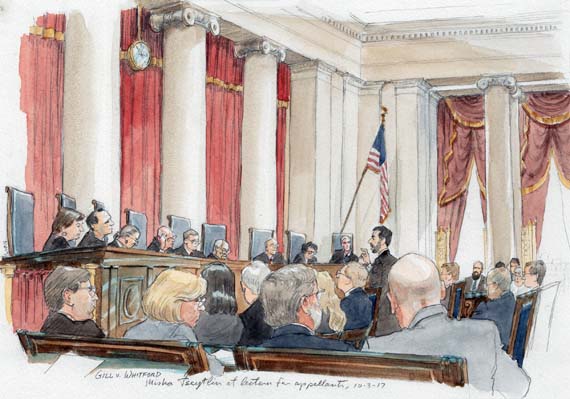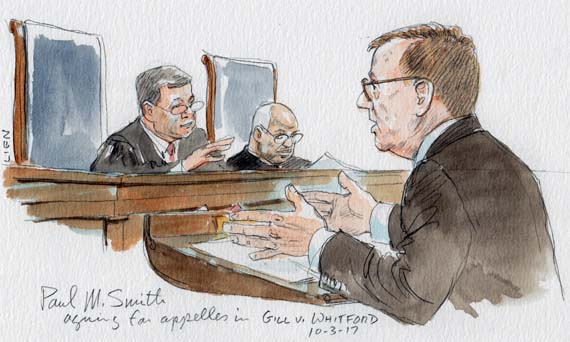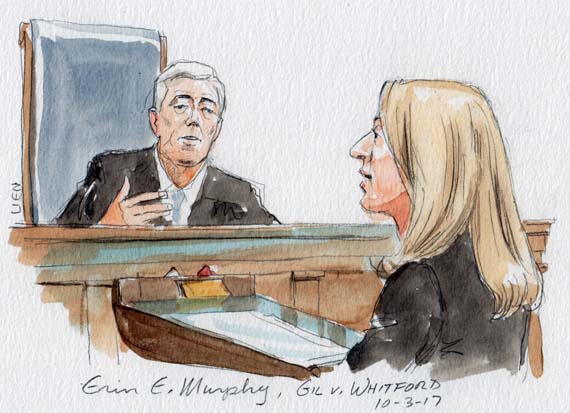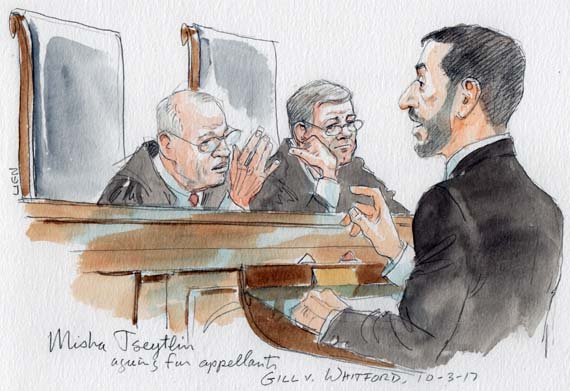Argument analysis: Cautious optimism for challengers in Wisconsin redistricting case?

on Oct 3, 2017 at 2:13 pm

Today may have been only the second day of the Supreme Court’s new term, but it may also prove to be one of the biggest. The justices heard oral argument in Gill v. Whitford, a challenge to the redistricting plan passed by Wisconsin’s Republican-controlled legislature in 2011. A federal court struck down the plan last year, agreeing with the plaintiffs that it violated the Constitution because it was the product of partisan gerrymandering – that is, the practice of purposely drawing district lines to favor one party and put another at a disadvantage. After roughly an hour of oral argument this morning, the justices seemed to agree that partisan gerrymandering is, as Justice Samuel Alito acknowledged, “distasteful.” But there was no apparent agreement about whether courts could or should get involved in policing the practice.

Misha Tseytlin at lectern arguing for appellants (Art Lien)
The case arose after Republicans won majorities in both houses of the Wisconsin legislature and captured the governor’s office, giving them control over the maps that were drawn after the 2010 census. In the 2012 elections, Republicans won slightly less than half of the statewide vote, which translated into 60 seats in the state’s 99-seat assembly; by contrast, Democrats won just over half of the statewide vote but garnered only 39 seats. Two years later, Republicans won 52% of the vote and 63 seats, while Democrats won approximately 48% of the vote and 36 seats.
A group of challengers argued that the new redistricting plan amounted to an unconstitutional partisan gerrymander. They contended that the new plan sought to dilute Democratic votes across the state, using two methods: “cracking,” which divides up supporters of one party among different districts so that they do not form a majority in any of them; and “packing,” which puts large numbers of a party’s supporters in relatively few districts, where they win by large margins.
The dispute went to a divided three-judge district court, which Congress has designated as the forum for redistricting challenges. That court regarded the case as an easy one. Although it may sometimes be difficult to tell when politics plays too influential a role in redistricting, the lower court conceded, this case is “far more straightforward”: The Republican-controlled legislature drafted a redistricting plan to lock in the party’s control of the state legislature, even though it could have created a different plan that would have accomplished redistricting goals without giving Republicans such a partisan advantage.
The district court may have regarded the case as a “straightforward” one, but few justices seemed to share that sentiment today. That’s not particularly surprising, because the issue of partisan gerrymandering has deeply divided the Supreme Court in the past. Thirteen years ago, the justices rejected a challenge to Pennsylvania’s redistricting plan, with four justices agreeing that courts should decline to review partisan-gerrymandering claims, because it is too hard to come up with a manageable test to determine when politics plays too influential a role in redistricting. Four other justices would have allowed courts to review partisan-gerrymandering claims. That left Justice Anthony Kennedy, who agreed that the Supreme Court should stay out of the Pennsylvania case but suggested that courts could play a role in reviewing partisan-gerrymandering cases in the future if a workable standard could be found.
Before the justices got to the merits of the case this morning, they tackled another question: whether the plaintiffs have a legal right – known as “standing” – to challenge the 2010 map at all, particularly because some of them live in heavily Democratic districts. Kennedy (whom many regard as the key vote in the case) acknowledged that the plaintiffs could not point to a specific Supreme Court case in their favor, but he asked Wisconsin Solicitor General Misha Tseytlin whether the plaintiffs might have standing if their claims were grounded in the First Amendment, rather than a right to equal protection of the laws. Kennedy seemed to suggest that they would, telling Tseytlin that such plaintiffs would have a First Amendment interest in having their preferred political party be strong, rather than weak.
Chief Justice John Roberts seemed to disagree. He told attorney Paul Smith, who argued on behalf of the plaintiffs challenging the map, that allowing plaintiffs in a partisan-gerrymandering case to challenge an entire map seemed inconsistent with the court’s rule that plaintiffs in racial-gerrymandering cases can only challenge their own districts, not the whole map.

Paul M. Smith arguing for appelles (Art Lien)
Smith countered that the two scenarios are different: In racial-gerrymandering cases, he argued, the claim does attack a specific district; by contrast, a plaintiff in a partisan-gerrymandering claim is challenging the dilution of one party’s votes statewide.
If five justices were to agree that the plaintiffs lack standing to challenge the whole map, it would allow them to avoid ruling on the merits of the case. But it does not look as though there are five votes for that outcome – especially if, as Kennedy’s comment suggests, he would allow the lawsuit to go forward. And so most of the one-hour argument today was spent on the substance of the case, and in particular on two closely related questions: Should the courts get involved in reviewing partisan-gerrymandering cases at all; and, if so, what standard should they use to review such claims?
Roberts made clear that, in his view, the Supreme Court should stay out – for the good of its institutional reputation. He told Smith that if the plaintiffs win, the courts would be flooded with partisan-gerrymandering claims, which would all wind up at the Supreme Court because, unlike in most cases, in which the court can choose which cases to review, the court is generally required to review redistricting challenges. For example, if the Supreme Court rules for the Democrats in a case, Roberts continued, most people will not understand that the decision rests on a complicated calculus. Instead, Roberts posited, the average person will say, “That’s a bunch of baloney,” and chalk the ruling up to a preference for the Democrats. And that, Roberts stressed, will cause very serious harm to the status and perceived integrity of the Supreme Court.
Smith pushed back, predicting that any potential harm to the Supreme Court’s reputation would pale in comparison with the harm to democracy if the state prevails. Partisan gerrymandering is already bad, he cautioned, but we are on the “cusp of a more serious problem” because officials drawing redistricting maps now have access to vast amounts of data, and because the electorate is now so polarized that voting has become more predictable than ever. If you uphold the Wisconsin map, he told Roberts ominously, the court will be confronted with a “festival of copycat gerrymandering,” and people will lose faith in democracy altogether.
Roberts was unconvinced, telling Smith that his rule would take democracy away from the legislatures based on social science “gobbledygook.” The court’s newest justice, Neil Gorsuch, was relatively quiet, but he appeared to show his cards when he asked Smith to name the source of the Supreme Court’s authority to revise state redistricting maps. The court should be cautious, Gorsuch emphasized, about stepping in here.
The plaintiffs seemed to find a more receptive audience in Justice Ruth Bader Ginsburg, who told Erin Murphy – arguing on behalf of the Wisconsin legislature – that the “precious right to vote” is at the heart of this case. If legislators can “stack” a legislature, so that the result of the election is “preordained,” she queried, where is the incentive for voters to actually go to the polls? “Society should be concerned,” Ginsburg concluded.

Erin E. Murphy arguing for Wisconsin State Senate (Art Lien)
Justice Sonia Sotomayor voiced similar concerns. She asked Murphy whether it was okay for one party to “stack the decks, so that for 10 years,” it could garner a minority of the vote but still win a majority of the seats in the legislature.
But although the justices spent some time at the 50,000-feet level, contemplating the broader implications of their ruling, much of their time was spent in the weeds, on what Justice Stephen Breyer described as another “hard issue” in the case: If courts are going to get involved with partisan-gerrymandering cases, what are manageable standards that they can apply to evaluate the claims? Breyer offered Tseytlin a five-part test that looked at, among other things, whether one party controls the legislature and the redistricting process; whether the redistricting maps create “partisan asymmetry” – that is, they do not treat the different political parties equally; and whether that asymmetry is “persistent” and extreme. “I suspect,” Breyer told Tseytlin, that the test is manageable.
Justice Elena Kagan seemed to agree. She observed that, if the technology now available to legislators is so good that legislators can draw the maps easily, the same techniques can be used on the back end to evaluate what the legislature was considering when it was drawing the maps. This is not “airy fairy,” she stressed, but instead “pretty scientific.”

Misha Tseytlin arguing for appellants (Art Lien)
Not surprisingly, Tseytlin disagreed. He maintained that the Supreme Court had already rejected some of these kinds of inquiries in its earlier cases. And he repeated a theme that would resurface throughout the hour: Any “standards” that the court might articulate to evaluate partisan-gerrymandering claims would rely heavily on statistics and battles between each side’s experts.
Murphy picked up this theme, reminding the justices that the kinds of standards that the plaintiffs have proposed have identified “false positives” – districts that appear to be the result of gerrymandering but are not – 50% of the time. What, she asked rhetorically, are legislatures supposed to do when confronted with problems like these?
Justice Samuel Alito was also skeptical. He told Smith that, although everyone has been looking for a manageable standard, one of the theories on which the plaintiffs relied – known as the “efficiency gap,” which looks at the number of votes “wasted” in each election, either because they are cast for the losing candidate or because the victorious candidate did not need them to win – was not developed until very recently. “Is this the time for us to jump into this,” Alito asked, when there are still so many questions about the theory?
Although it was obvious that, for Alito, the answer was “no,” for Smith the answer was “yes.” In the 2004 redistricting case, the court provided a blueprint for future partisan-gerrymandering challengers: They would need to give the court manageable standards to evaluate their claims. And that is exactly what social scientists have done, Smith argued. In this case, the district court used three different social-science standards and concluded that the 2010 Wisconsin map was, for purposes of partisan gerrymandering, one of the worst maps ever.
Kagan seemed to be on board with Breyer’s standard, but looked for reassurance that the courts would not be inundated with challenges to other redistricting maps in the future. Smith suggested a variety of measures that seemed to placate Kagan, but not Roberts, who complained that the kind of statistics-based predictions that Smith’s measures would call for had “been a very hazardous exercise” for the court in the past. Alito also complained about the “dozens of uncertainties” in the process that Smith was proposing.
Perhaps notably, Kennedy did not ask Smith any questions at all during Smith’s 30 minutes at the lectern – which, although there’s no way to know, would seem to bode well for the challengers. Smith seemed to direct his closing remarks straight at Kennedy, as he told the justices that if they do not act now, it could be too late. We’ll know by the end of June whether and how the court will act.
This post was originally published at Howe on the Court.


